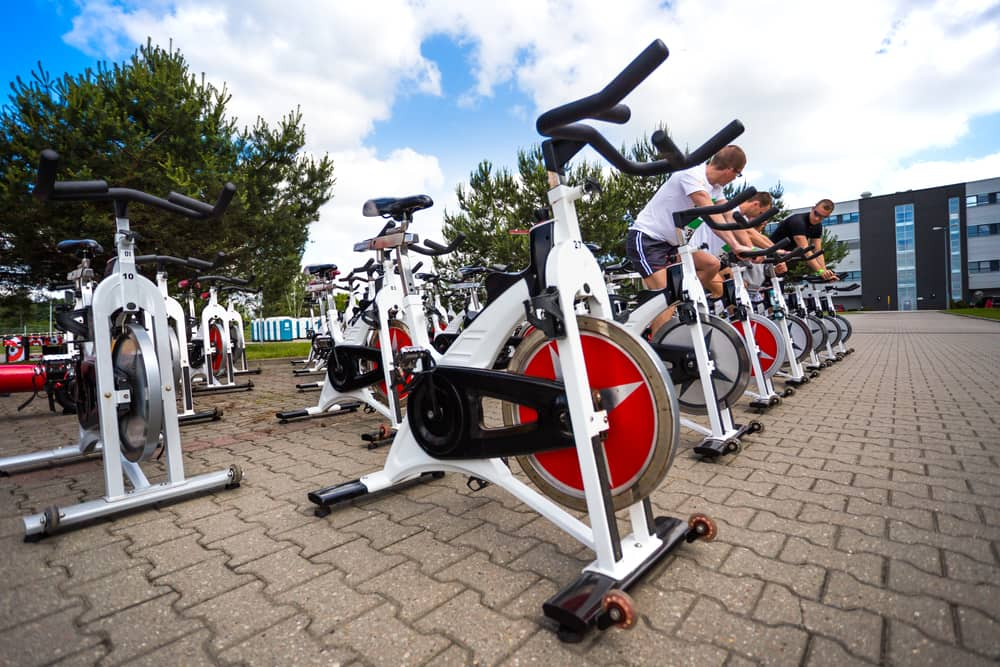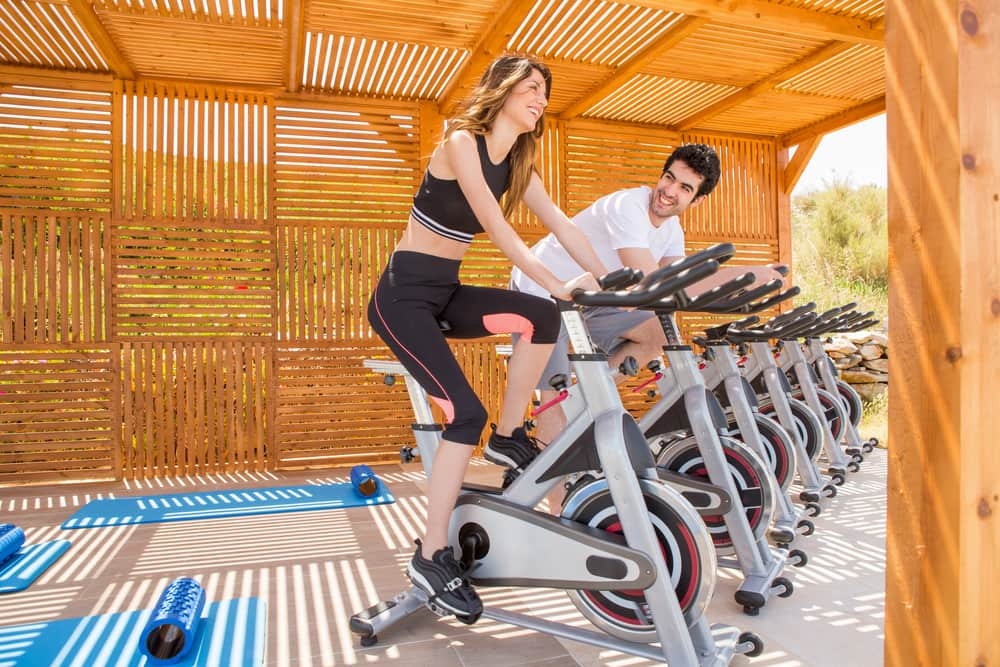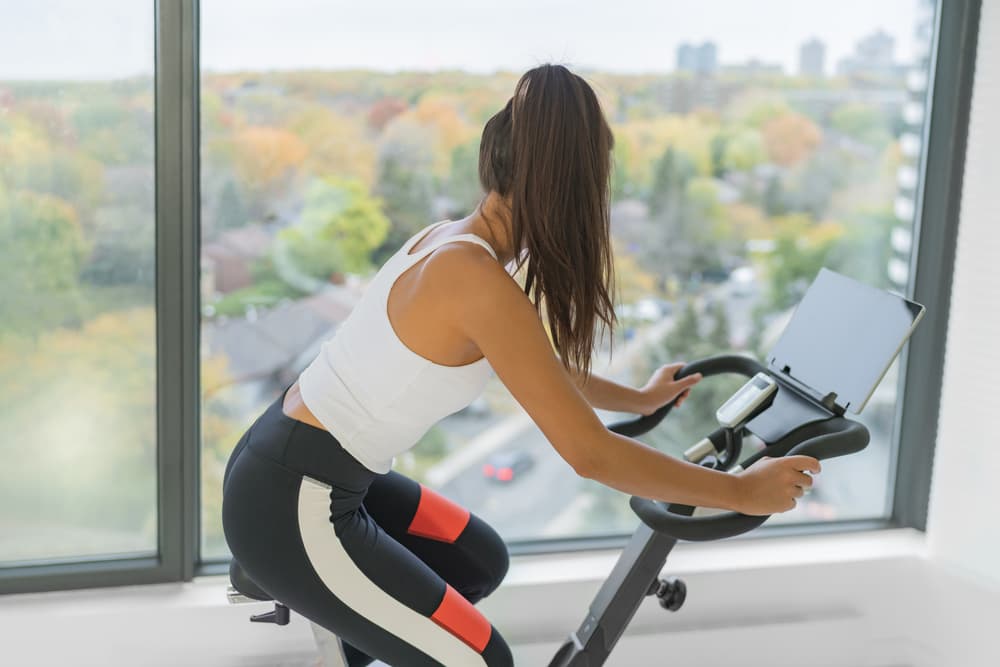Storing a stationary bike outside is not recommended. Exercise bikes have metal and electronic components that could deteriorate fast when exposed to outside elements and weather changes. Outdoor elements like dust particles can accumulate inside the exercise equipment and wear out moving parts.
To learn more, let’s determine why you should keep your exercise bike indoors. I also listed some alternatives and storage tips to preserve the quality and life of your fitness machine.
4 Reasons Why You Should Not Keep Exercise Bikes Outdoors
Some people keep their indoor cycling bikes outside to save indoor space. Others like working out with fresh air and a scenic view. No matter your purpose, resist leaving your stationary bikes by the pool, backyard or garage.
Below details 4 reasons why you should not keep exercise bikes outdoors.

1. Dust can damage bike parts and bearings.
Regular cleaning and maintenance of your exercise bike are essential to prevent dust build-up. Dust and dirt accumulation happens over time. Your exercise bike gets dusty even faster when you keep it outdoors.
It’s much easier for small particles to find their way inside the machine and get into moving parts and bearings. These areas are often harder to reach and clean thoroughly.
If you let dust accumulate, your exercise bike may not run as smoothly as before. You might even call for repairs or require replacement parts sooner than expected.
2. Weather varies from region to region.
Considering current climate changes, it’s hard to assume that your outdoor environment is safe year-round for fitness machines. Some areas experience very cold or hot seasons. Other regions are humid, too. These temperature changes are harder to control when you leave your exercise bike outside.
Remember, your bike comes with plastic and metal parts that can easily break, discolour or corrode under extreme temperatures and excess moisture. If your bike has a lot of electronic components, it can break down fast when exposed to different conditions, too.
Covering your exercise bike with a waterproof cover will not protect it from weather damage, either. Air can still carry moisture into your equipment, causing it to age much faster.
3. Rough or uneven flooring is not ideal for a workout.
Garage, garden or pool areas typically have rough floors to create a non-slip surface. However, these are not good for your exercise bike.
The extra bumps on the flooring can cause your machine to rock, move or make unusual noises. These may eventually affect machine performance and lifespan. Working out on an unlevelled surface is a safety concern, too.
4. Theft is always a possibility.
Parked cars, scooters and outdoor bikes get stolen every day. An exercise bike sitting on your porch is an even easier target. Of course, the risk depends on your neighbourhood. And you can probably chain up your machine to a pole. Still, storing your exercise bike indoors is a more practical and safer solution.

Alternatives and Tips for Easy Exercise Bike Storage
If you want your exercise bike to last long, storing it outdoors is the last thing you’d do. However, there are ways you can do your cycling routine outside.
These storage tips should also make it easier for you to keep your bike indoors.
- Get a spin bike. This bike type is simple, lightweight and compact. It should be easy to get in and outside when you want to. It’s even better when your outdoor workout area is close to the main house, like a shed or garage. Ideally, find a model with a handle and transport wheels for portability.
- Find an indoor spot facing the outdoors. Instead of wheeling your machine in and outside the house, position your bike in an area with windows. Make sure it has ample space, with floors made of concrete or wood. Use an exercise mat for stability and surface protection, too.
- Place the exercise bike on the ground floor or in the basement. Are you using and keeping your exercise bike outdoors to lessen the noise? If so, turning a vacant room or your basement into a permanent workout spot is a better alternative. If you don’t have one, place your bike anywhere indoors but adjust your exercise schedule to avoid disturbing others.
- Work out with a real bike. Riding a real bike is probably the best solution if you enjoy using the exercise bike and going outdoors. Outdoor bikes do not have electrical components and can withstand weather changes. With one at home, you even get an alternate mode of transportation when the need arises!
Bottom Line
Stationary bikes are not as expensive as other fitness machines. However, they are still health investments that need proper use and care.
One way to do that is to avoid leaving exercise bikes outdoors. Doing so should preserve your equipment’s quality and lifespan. There’s no need to frequently clean and check your machine either.
Moreover, you can avoid unnecessary repair or replacement part expenses. Reviewing the exercise bike model you want to own is the key takeaway. Make sure to check its size, so you can prep a dedicated space for it indoors.

Related Questions
1. Do indoor bikes burn more calories than outdoor bikes?
According to Harvard Health Publishing, a 57-kg individual can burn 210-315 calories in a 30-minute stationary biking session. On the other hand, outdoor cycling has a slightly higher calorie burn (240-495 calories) under the same conditions. Both cycling options have their pros and cons, though. So, it’s best to choose one that matches your lifestyle.
2. Which type of exercise bike resembles an outdoor bike?
Spin bikes have the seat and handlebar at almost the same height. This positioning allows you to lean your upper body while pedalling, giving you a feeling similar to outdoor cycling. Some bike models, like the NordicTrack Commercial S22i, also have an adjustable incline and global workouts to simulate outdoor bike sessions.
3. Is walking better than riding an exercise bike?
Walking and riding bikes are different physical activities with strengths and weaknesses. The choice between the two depends on your needs and capabilities. For instance, indoor cycling is best if you want to burn more calories. But walking is better if you prefer getting stronger bones without buying an exercise machine. When you can, put both forms of exercise in your routine for variety and optimum benefits.
- Elliptical Cross Trainer vs Exercise Bike: Which is Better? - 24 June 2025
- How Do the Different Massage Gun Attachments Work? - 23 June 2025
- What is the Best Equipment for a Small Home Gym? - 29 May 2025
